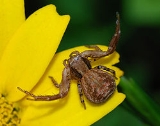
Xysticus
Encyclopedia
Xysticus is a genus of ground crab spiders described by C. L. Koch in 1835, belonging to the order Araneae, family Thomisidae. The genus name is derived from the Ancient Greek
root xyst, meaning "scraped, scraper".
The species of the genus Xysticus vary usually from small to medium. They show a sexual dimorphism in size. The females reach a maximum of 10 millimetre (0.393700787401575 in) of body length, while males are about 3–5 mm (0.118110236220472–0.196850393700787 ) long, about half the size of the females.
The basic colour of theese species is usually brown, beige or gray. The prosoma is sometimes slightly smaller than the opisthosoma
. In many species the front body shows in the middle a broad, pale longitudinal band. The opisthosoma
is clearly flattened in most species and shows a median broad and dark leaf marking.
The species are often very similar to each other, and in most cases can be distinguished only by a microscopic examination of the reproductive organs.
passes close enough. The prey is seized with the enlarged first two pairs of legs and killed by a bite.
Ancient Greek
Ancient Greek is the stage of the Greek language in the periods spanning the times c. 9th–6th centuries BC, , c. 5th–4th centuries BC , and the c. 3rd century BC – 6th century AD of ancient Greece and the ancient world; being predated in the 2nd millennium BC by Mycenaean Greek...
root xyst, meaning "scraped, scraper".
Distribution
The genus Xysticus is distributed almost worldwide, but it is absent in South America. Of the about 360 species of the genus currently described, only about 71 are present in Europe.Description
Xysticus and Coriarachne are the dark brown or reddish-brown crab spiders often encountered on weeds or trees. While similar to the 'flower spiders', they tend to have shorter, sturdier legs and more patterned abdomens.The species of the genus Xysticus vary usually from small to medium. They show a sexual dimorphism in size. The females reach a maximum of 10 millimetre (0.393700787401575 in) of body length, while males are about 3–5 mm (0.118110236220472–0.196850393700787 ) long, about half the size of the females.
The basic colour of theese species is usually brown, beige or gray. The prosoma is sometimes slightly smaller than the opisthosoma
Opisthosoma
The opisthosoma is the posterior part of the body in some arthropods, behind the prosoma . It is a distinctive feature of the subphylum Chelicerata...
. In many species the front body shows in the middle a broad, pale longitudinal band. The opisthosoma
Opisthosoma
The opisthosoma is the posterior part of the body in some arthropods, behind the prosoma . It is a distinctive feature of the subphylum Chelicerata...
is clearly flattened in most species and shows a median broad and dark leaf marking.
The species are often very similar to each other, and in most cases can be distinguished only by a microscopic examination of the reproductive organs.
Behaviour
The spiders of the genus Xysticus do not build nets, as they are ambush hunters and prefer to hunt near the ground (hence the common name). They move slowly, and tend to hunt by stationing themselves in a high-traffic area and grabbing whatever arthropodArthropod
An arthropod is an invertebrate animal having an exoskeleton , a segmented body, and jointed appendages. Arthropods are members of the phylum Arthropoda , and include the insects, arachnids, crustaceans, and others...
passes close enough. The prey is seized with the enlarged first two pairs of legs and killed by a bite.
External links
- Pictures of Xysticus triguttatus (free for noncommercial use)
- Xysticus BugGuide
- Davesgarden
- Greennature

